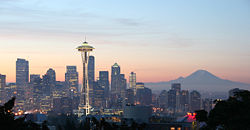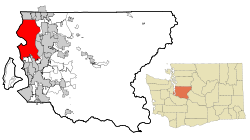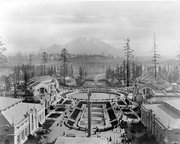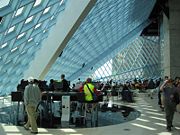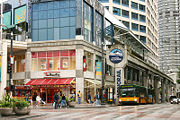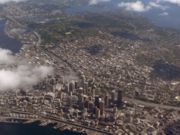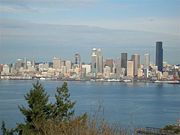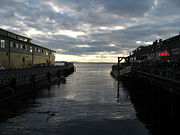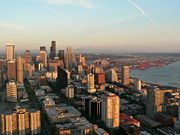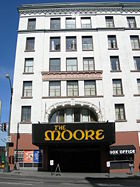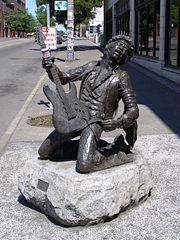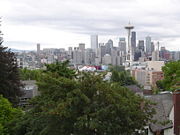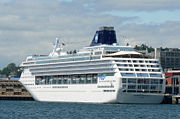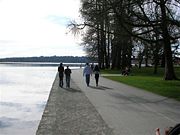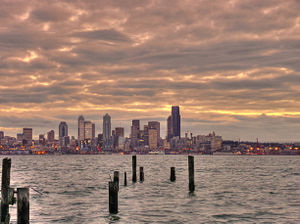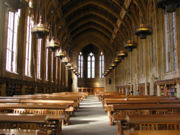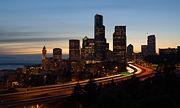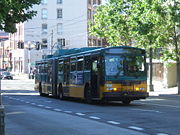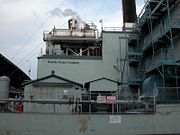Seattle, Washington
2008/9 Schools Wikipedia Selection. Related subjects: Cities; North America
| City of Seattle | |||
|
|||
| Nickname: The Emerald City, Frasierland | |||
|
Location of Seattle in King County and Washington |
|||
| Coordinates: | |||
|---|---|---|---|
| Country | United States | ||
| State | Washington | ||
| County | King | ||
| Incorporated | December 2, 1869 | ||
| Government | |||
| - Type | Mayor– council | ||
| - Mayor | Greg Nickels (D) | ||
| Area | |||
| - City | 142.5 sq mi (369.2 km²) | ||
| - Land | 83.87 sq mi (217.2 km²) | ||
| - Water | 58.67 sq mi (152.0 km²) | ||
| - Metro | 8,186 sq mi (21,202 km²) | ||
| Elevation | 0–520 ft (0–158 m) | ||
| Population ( July 1, 2006) | |||
| - City | 582,454 | ||
| - Density | 6,901/sq mi (2,665/km²) | ||
| - Urban | 3,263,497 | ||
| - Metro | 3,919,624 | ||
| Time zone | PST ( UTC-8) | ||
| - Summer ( DST) | PDT ( UTC-7) | ||
| ZIP codes | 98101, 98102, 98103, 98104, 98105, 98106, 98107, 98108, 98109, 98110, 98111, 98112, 98113, 98114, 98115, 98116, 98117, 98118, 98119, 98121, 98122, 98124, 98125, 98126, 98127, 98129, 98131, 98132, 98133, 98134, 98136, 98138, 98139, 98141, 98144, 98145, 98146, 98148, 98151, 98154, 98155, 98158, 98160, 98161, 98164, 98165, 98166, 98168, 98170, 98171, 98174, 98175, 98177, 98178, 98181, 98184, 98185, 98188, 98190, 98191, 98194, 98195, 98198, 98199 | ||
| Area code(s) | 206 | ||
| FIPS code | 53-63000 | ||
| GNIS feature ID | 1512650 | ||
| Website: www.seattle.gov | |||
Seattle (pronounced /siˈætl ̩/) is a coastal port city and the largest city in the Pacific Northwest region of the United States. It is located in the state of Washington between an arm of the Pacific Ocean called Puget Sound and Lake Washington, about 96 miles (154 km) south of the Canada – United States border in King County, of which it is the county seat.
The Seattle area has been inhabited for at least 4,000 years, but European settlement began only in the mid-19th century. The first permanent white settlers— Arthur A. Denny and those subsequently known as the Denny party—arrived November 13, 1851. Early settlements in the area were called "New York-Alki" ("Alki" meaning "by and by" in the local Chinook Jargon) and "Duwamps". In 1853, Doc Maynard suggested that the main settlement be renamed "Seattle", an anglicized rendition of the name of Sealth, the chief of the two local tribes. In 2006, the city had an estimated population of 582,454 and an estimated metropolitan area population of approximately 3.2 million. Seattle is the hub and largest city of the Seattle metropolitan area, often called Puget Sound, which also includes Tacoma, Bellevue, and Everett. From 1869 until 1982, Seattle was known as the "Queen City". Seattle's current official nickname is the "Emerald City", the result of a contest held in the early 1980s; the reference is to the lush evergreen trees in the surrounding area. Seattle is also referred to informally as the "Gateway to Alaska", "Rain City", "Coffee Town", and "Jet City", the latter from the local influence of Boeing. Seattle residents are known as Seattleites.
Seattle is the birthplace of grunge music and has a reputation for heavy coffee consumption; coffee companies founded or based in Seattle include Starbucks, Seattle's Best Coffee, and Tully's. There are also many successful independent artisanal espresso roasters and cafes. Researchers at Central Connecticut State University ranked Seattle the most literate city of America's sixty-nine largest cities in 2005 and 2006 and second most literate in 2007. Moreover, analysis conducted in 2004 by the United States Census Bureau of 2002 survey data indicated that Seattle was the most educated large city in the U.S. with 48.8 percent of residents 25 and older having at least bachelor degrees. Based on per capita income, in 2006 the Seattle metropolitan area ranked 17th out of 363 metropolitan areas in a study by the Census Bureau.
Seattle was the site of the 1999 meeting of the World Trade Organization, and the attendant demonstrations by anti-globalization activists. The city is also home to the Pride Foundation, which became the best-funded LGBT rights organization in the US when Ric Weiland, one of the first five Microsoft employees, bequeathed $65 million to the foundation as well as ten other organizations.
History
Founding
What is now Seattle has been inhabited since the end of the last ice age. Archaeological excavations at West Point in Discovery Park, Magnolia, confirm that the Seattle area has been inhabited by humans for at least 4,000 years. tohl-AHL-too ("herring house") and later hah-AH-poos ("where there are horse clams") at the mouth of the Duwamish River in what is now the Industrial District has been inhabited since the 6th century BC. By the time the first European settlers arrived in the area, the Dkhw'Duw'Absh and Xachua'Bsh people (now called the Duwamish Tribe) occupied at least seventeen villages in the areas around Elliott Bay.
The first Europeans to attempt settlement in the area were the Collins Party, who filed legal claim to land at the mouth of the Duwamish River on September 14, 1851. Thirteen days later, members of the Collins Party were on the way to their claim when they passed the scouts of the group of settlers that would eventually found Seattle, the Denny Party. The scouts for the Denny Party, Terry Lee, David Denny, and John Low, would lay claim to land on Alki Point on September 28, 1851, with Terry Low returning to Portland, Oregon carrying a message from David Denny telling his brother, Arthur Denny, to "Come at once." Following the instructions of David Denny, the rest of the Denny Party set sail from Portland and landed on Alki during a rainstorm on November 13, 1851. The landing party's first sight of their new homestead was the roofless cabin that David had been unable to complete because of a fever.
After spending a winter of frequent rainstorms and high winds on Alki Point, most of the Denny Party moved across Elliott Bay and settled on land where present day Pioneer Square is located and established the village of "Dewamps" or "Duwamps." The only members of the party that did not migrate to the eastern shore of Elliott Bay were Charles Terry and John Low, who remained at the original landing location and established a village they initially called "New York," after Terry's hometown, until April 1853 when they renamed it "Alki," a Chinook word meaning, roughly, by and by or someday. The villages of New York-Alki and Duwamps would compete for dominance in the area for the next few years, but in time Alki was abandoned and its residents moved across the bay to join the rest of the settlers.
David Swinson ("Doc") Maynard, one of the village's founders, was the primary advocate for renaming the village to "Seattle" after Chief Sealth (si'áb Si'ahl) of the Duwamish and Suquamish tribes. Doc Maynard's advocacy bore fruit, because when the first plats for village were filed on May 23, 1853, it was for the Town of Seattle. In 1855, nominal legal land settlement were established and the city was incorporated in 1865 and again in 1869, after having existed as an unincorporated town from 1867 to 1869.
Major events
Major events in Seattle's history include:
- The Great Seattle Fire of 1889, which destroyed the central business district (but took no lives)
- The anti-Chinese riots of 1885–1886
- The Klondike gold rush, which made Seattle a major transportation centre
- The Alaska-Yukon-Pacific Exposition of 1909, which is largely responsible for the layout of the University of Washington campus
- The Seattle General Strike of 1919, the first general strike in the country
- The 1962 Century 21 Exposition, a World's Fair
- The 1990 Goodwill Games
- The APEC leaders conference in 1993
- The WTO Ministerial Conference of 1999, marked by street protests and a series of riots
- The Seattle Mardi Gras Riots in 2001 followed by an earthquake the next day.
Economic history
Seattle has a history of boom and bust cycles, common to cities near large areas of natural and mineral resources. Seattle has several times risen as a company town or through economic specialization, then gone into precipitous decline, but it has typically used those periods to successfully rebuild infrastructure.
The first such boom, covering the early years of the city, was fueled by the lumber industry. (During this period the road now known as Yesler Way was nicknamed "Skid Road" after the timber skidding down the hill to Henry Yesler's sawmill. The term later entered the wider American vocabulary as Skid Row.) This boom was followed by the construction of an Olmsted-designed park system.
The second and most dramatic boom was the direct result of the Klondike Gold Rush of 1896, which ended the national depression that had begun with the Panic of 1893. On July 14, 1897, the S.S. Portland docked with its famed "ton of gold", and Seattle became the main transport and supply point for those heading north. The boom lasted well into the early part of the 20th century and funded many new Seattle companies and products. Finance company Washington Mutual was founded in 1889, in an attempt to save Seattle's economy after the Great Seattle fire. In 1907, 19-year-old James E. Casey borrowed $100 from a friend and founded the American Messenger Company (later UPS). Other Seattle companies founded during this period include Nordstrom and Eddie Bauer.
Next came the shipbuilding boom in the early part of the 20th century, followed by the unused city development plan of Virgil Bogue. Seattle was the major point of departure during World War II for troops heading to the North Pacific, and Boeing manufactured many of the war's bombers.
The local economy dipped after the war, but rose again with the expansion of Boeing, fueled by the growth of the commercial aviation industry. When this particular cycle went into a major downturn in the late 1960s and early 1970s, many left the area to look for work elsewhere, and two local real estate agents put up a billboard reading "Will the last person leaving Seattle – Turn out the lights."
Seattle remained the corporate headquarters of Boeing until 2001, when the company announced a desire to separate its headquarters from its major production facilities. Following a bidding war among a number of major cities, Boeing moved its corporate headquarters to Chicago. The Seattle area is still home to Boeing's Renton narrow-body plant (where the 707, 720, 727, and 757 were assembled, and the 737 is assembled today) and Everett wide-body plant (assembly plant for the 747, 767, 777 and the upcoming 787 Dreamliner), as well as BECU, formerly the Boeing Employees Credit Union.
Next, technology companies, including Microsoft, Amazon.com, RealNetworks, McCaw Cellular (now part of AT&T Mobility), VoiceStream (now T-Mobile USA), and biomedical corporations such as HeartStream (later purchased by Philips), Heart Technologies (later purchased by Boston Scientific), Physio-Control (later purchased by Medtronic), ZymoGenetics, ICOS (later purchased by Eli Lilly & Co.) and Immunex (later purchased by Amgen), found homes in Seattle and its suburbs. This success brought an influx of new citizens with a population increase within city limits of almost 50,000 between the 1990 and 2000 Census and saw Seattle's real estate become some of the most expensive in the country. Many of these companies remain relatively strong, but the frenzied dot-com boom years ended in early 2001.
Geography
Topography
Seattle is located between an inlet of the Pacific Ocean to the west called Puget Sound and Lake Washington to the east. The city's chief harbour, Elliott Bay, is an inlet of the Sound. West beyond the Sound are the Kitsap Peninsula and Olympic Mountains, on the Olympic Peninsula; east beyond Lake Washington and the eastside suburbs are Lake Sammamish and the Cascade Range. Lake Washington flows through the Lake Washington Ship canal, a series of two man made canals and Lake Union, to the Hiram C. Chittendon Locks and into Salmon Bay, which is part of Puget Sound. The sea, rivers, forests, lakes, and fields were once rich enough to support one of the world's few sedentary hunter-gatherer societies. Opportunities for sailing, skiing, bicycling, camping, and hiking are nearby and accessible almost year-round.
The city itself is hilly, though not uniformly so. Like Rome, the city is said to lie on seven hills; the lists vary, but typically include Capitol Hill, First Hill, West Seattle, Beacon Hill, Queen Anne, Magnolia, and the former Denny Hill. The Wallingford and Mount Baker neighbourhoods are technically located on hills as well. Many of the hilliest areas are near the city center, with Capitol Hill, First Hill, and Beacon Hill collectively constituting something of a ridge along an isthmus between Elliott Bay and Lake Washington. The topography of the city centre has been reshaped by regrading projects, a seawall, and the construction of an artificial island, Harbour Island (completed 1909), at the mouth of the city's industrial Duwamish Waterway.
The man-made Lake Washington Ship Canal incorporates four natural bodies of water: Lake Union, Salmon Bay, Portage Bay, and Union Bay, connecting Puget Sound to Lake Washington.
Seattle is in an earthquake zone and has experienced a number of significant quakes, most recently (as of 2007) the magnitude 6.8 Nisqually Earthquake, February 28, 2001, which did significant architectural damage, especially in the Pioneer Square area (built on reclaimed land, as are the Industrial District and part of the city centre), but caused no fatalities. Other strong quakes occurred on December 14, 1872 (estimated at 7.3 or 7.4 magnitude), April 13, 1949 (7.1), and April 29, 1965 (6.5). The 1949 quake caused eight known deaths, all in Seattle; the 1965 quake caused three deaths in Seattle directly, and one more by heart failure. Although the Seattle Fault passes just south of the city centre, neither it nor the Cascadia subduction zone has caused an earthquake since the city's founding. The Cascadia subduction zone poses the threat of an earthquake of magnitude 9.0 or greater, capable of seriously damaging the city and collapsing many buildings, especially in zones built on fill.
According to the United States Census Bureau, the city has a total area of 369.2 km² (142.5 mi²), 217.2 km² (83.9 mi²) of which is land and 152.0 km² (58.7 mi²) water. The total area is 41.16% water.
Climate
Seattle's mild climate is usually classified as Marine west coast (Cfb). However, its wet-winter/dry-summer pattern shows some characteristics of a Mediterranean climate (Csb), and it is sometimes classified this way. Temperature extremes are moderated by adjacent Puget Sound, the greater Pacific Ocean, and Lake Washington. The region is partially protected from Pacific storms by the Olympic Mountains and from Arctic air by the Cascade Range. Despite being on the margin of the rain shadow of the Olympic Mountains, the city has a reputation for frequent rain. Despite its relatively frequent rainfall, the so-called "rainy city" receives a smaller quantity of actual precipitation annually, at 37.1 inches (94 cm), than New York City, Atlanta, Houston, and most cities of the Eastern Seaboard of the United States. Seattle was also not listed in a study that revealed the 10 Rainiest Cities in the continental United States. Seattle's reputation for rain derives from this frequency of precipitation as well as the fact that it is cloudy an average of 226 days per year (cf. 132 in New York City). Most of the precipitation falls as drizzle or light rain, with only occasional downpours. Spring, late fall, and winter are filled with days when it does not rain but looks as if it might because of cloudy, overcast skies. As for temperature, winters are cool and wet with average lows around 35–40 °F (2–4 °C) on winter nights. Colder weather can occur, but seldom lasts more than a few days. Summers are dry and warm, with average daytime highs around 73–80 °F (22.2–26.7 °C). Hotter weather usually occurs only during a few summer days. Seattle's hottest official recorded temperature was 100 °F (37.8 °C) on July 20, 1994; the coldest recorded temperature was 0 °F (-18 °C) on January 31, 1950.
Eighty miles (130 km) to the west, the Hoh Rain Forest in Olympic National Park on the western flank of the Olympic Mountains receives an annual average rainfall of 142 inches (361 cm), and the state capital, Olympia—south of the rain shadow—receives an annual average rainfall of 52 inches (132 cm). Snowfall is very infrequent, especially at lower altitudes and near the coast, and is usually light and fleeting, lasting only a few days. Average annual snowfall, as measured at Sea–Tac Airport, is 13 inches (33 cm). Seattle's record snowfall was 20 inches (51 cm) on January 13, 1950. Sunnier and drier " California weather" typically dominates from mid-July to mid-September. An average of 0.8 inches (2.0 cm) of rain falls in July and 1.0 inch (2.5 cm) in August. Although the summer climate is considerably drier and less humid than in areas with humid continental climates, a slight dampness can be occasionally felt, usually when temperatures reach above 80 °F (26.7 °C). This dampness is typically more noticeable during the evening when the temperatures have dropped. Because of this, Seattle experiences occasional summer thunderstorms.
The Puget Sound Convergence Zone is an important feature of Seattle's weather. In the convergence zone, air arriving from the north meets air flowing in from the south. Both streams of air originate over the Pacific Ocean; airflow is split by the Olympic Mountains to Seattle's west, then reunited by the Cascade Mountains to the east. When the air currents meet, they are forced upward, resulting in convection.
Thunderstorms caused by this activity can occur north and south of town, but Seattle itself rarely receives worse weather than occasional thunder and ice-pellet showers. Nonetheless, the Hanukkah Eve Wind Storm in December 2006 brought heavy rain and winds gusting up to 69 mph (111 km/h). One Seattleite drowned in her collapsed and flooded basement; power failures were widespread, with some left without power for up to eleven days.
An exception to Seattle's dampness often occurs in El Niño years, when the marine weather systems track as far south as California and little precipitation falls in the Puget Sound area. Since the region's water comes from mountain snowpacks during the drier summer months, El Niño winters can not only produce substandard skiing but can result in water rationing and a shortage of hydroelectric power the following summer.
| Weather averages for Seattle, Washington | |||||||||||||
|---|---|---|---|---|---|---|---|---|---|---|---|---|---|
| Month | Jan | Feb | Mar | Apr | May | Jun | Jul | Aug | Sep | Oct | Nov | Dec | Year |
| Record high °F (°C) | 67 (19) | 70 (21) | 78 (26) | 87 (31) | 93 (34) | 98 (37) | 100 (38) | 99 (37) | 98 (37) | 89 (32) | 74 (23) | 65 (18) | 100 (38) |
| Average high °F (°C) | 46 (8) | 50 (10) | 53 (12) | 58 (14) | 64 (18) | 70 (21) | 75 (24) | 76 (24) | 70 (21) | 60 (16) | 51 (11) | 46 (8) | 60 (16) |
| Average low °F (°C) | 36 (2) | 37 (3) | 39 (4) | 42 (6) | 47 (8) | 52 (11) | 55 (13) | 56 (13) | 52 (11) | 46 (8) | 40 (4) | 36 (2) | 45 (7) |
| Record low °F (°C) | 0 (-18) | 1 (-17) | 11 (-12) | 29 (-2) | 16 (-9) | 38 (3) | 47 (8) | 44 (7) | 35 (2) | 19 (-7) | 0 (-18) | 6 (-14) | 0 (-18) |
| Precipitation inches (mm) | 5.1 (129.5) | 4.2 (106.7) | 3.8 (96.5) | 2.6 (66) | 1.8 (45.7) | 1.5 (38.1) | 0.8 (20.3) | 1.0 (25.4) | 1.6 (40.6) | 3.2 (81.3) | 5.9 (149.9) | 5.6 (142.2) | 37.1 (942.3) |
| Source: Weather.com July 2007 | |||||||||||||
Neighborhoods
Seattle has grown through a series of annexations of smaller neighboring communities. On May 3, 1891, Magnolia, Wallingford, Green Lake, and the University District (then known as Brooklyn) were annexed. The town of South Seattle was annexed on October 20, 1905. Between January 7 and September 12, 1907, Seattle nearly doubled its land area by annexing six incorporated towns and areas of unincorporated King County, including Southeast Seattle, Ravenna, South Park, Columbia, Ballard, and West Seattle. Three years later, after having difficulties paying a $10,000 bill from the county, the town of Georgetown merged with Seattle. Finally, on January 4, 1954, the area between N. 85th Street and N. 145th Street was annexed, including the neighborhoods of Maple Leaf, Lake City, and Northgate.
Seattle mayor Greg Nickels is among those who have called Seattle "a city of neighborhoods," although the boundaries (and even names) of those neighborhoods are often open to dispute. For example, a Department of Neighborhoods spokeswoman reported that her own neighbourhood has gone from "the 'CD' ( Central District) to 'Madrona' to 'Greater Madison Valley' and now 'Madrona Park.'"
Over a dozen Seattle neighborhoods have Neighbourhood Service Centers, originally known in 1972 as "Little City Halls" and many having street fairs and parades during the summer months. The largest of the city's street fairs feature hundreds of craft and food booths and multiple stages with live entertainment, and draw more than 100,000 people over the course of a weekend. In addition, at least half a dozen neighborhoods have weekly farmers' markets, some with as many as fifty vendors.
The residents of White Centre, an unincorporated neighbourhood between Seattle and Burien, are in the process of deciding by which of the two cities they will be annexed.
Cityscape
Landmarks
The Space Needle, dating from the Century 21 Exposition (1962), is Seattle's most recognizable landmark, having been featured in the logo of the television show Frasier and the backgrounds of the television series Grey's Anatomy and iCarly, and films such as Sleepless in Seattle. The fairgrounds surrounding the Needle have been converted into Seattle Centre, which remains the site of many local civic and cultural events, such as Bumbershoot, Folklife, and the Bite of Seattle. Seattle Center plays multiple roles in the city, ranging from a public fair grounds to a civic centre, though recent economic losses have called its viability and future into question. The Seattle Centre Monorail was also constructed for Century 21 and still runs from Seattle Centre to Westlake Centre, a Downtown shopping mall, a little over a mile to the southeast.
The Smith Tower was the tallest building on the West Coast from its completion in 1914 until the Space Needle overtook it in 1962. The late 1980s saw the construction of Seattle's two tallest skyscrapers: the 76 story Columbia Centre (completed 1985) is the tallest building in the Pacific Northwest and the fourth tallest building west of the Mississippi River; the Washington Mutual Tower (completed 1988) is Seattle's second tallest building. Other notable Seattle landmarks include Pike Place Market, the Fremont Troll, the Experience Music Project (at Seattle Centre), and the Seattle Central Library.
Starbucks has been at Pike Place Market since the coffee company was founded there in 1971. The first store is still operating a block south of its original location. Starbucks Centre, the company's current headquarters, is the largest building in Seattle by volume at just over 2,000,000 square feet (186,000 m²). The building, once Sears' Northwest catalog distribution centre, also contains a Sears and an OfficeMax store.
The National Register of Historic Places has over a hundred and fifty Seattle listings.
Culture
Seattle has been a regional centre for the performing arts for many years. The century-old Seattle Symphony Orchestra is among the world's most recorded and performs primarily at Benaroya Hall. The Seattle Opera and Pacific Northwest Ballet, which perform at McCaw Hall (opened 2003 on the site of the former Seattle Opera House at Seattle Centre), are comparably distinguished, with the Opera being particularly known for its performances of the works of Richard Wagner and the PNB School (founded in 1974) ranking as one of the top three ballet training institutions in the United States. The Seattle Youth Symphony Orchestras (SYSO) is the largest symphonic youth organization in the United States.
The 5th Avenue Theatre, built in 1926, stages Broadway-style musical shows featuring both local talent and international stars. Seattle has "around 100" theatrical production companies and over two dozen live theatre venues, many of them associated with fringe theatre; Seattle is probably second only to New York for number of equity theaters(28 Seattle theatre companies have some sort of Actors' Equity contract). In addition, the 900-seat Romanesque Revival Town Hall on First Hill hosts numerous cultural events, especially lectures and recitals..
Seattle is considered the home of grunge music because it was home to artists such as Nirvana, Pearl Jam, Soundgarden, and Alice in Chains, all of whom reached vast audiences in the early 1990s. The city is also home to such varied musicians as avant-garde jazz musicians Bill Frisell and Wayne Horvitz, rapper Sir Mix-a-Lot, smooth jazz saxophonist Kenny G, Heart, heavy metal bands Queensryche and Nevermore, underground rap duos Blue Scholars and Common Market, and such poppier rock bands as Harvey Danger, Goodness and the Presidents of the United States of America. Such musicians as Jimi Hendrix, Duff McKagan, Nikki Sixx, and Quincy Jones spent their formative years in Seattle.
Since the grunge era, the area has hosted a diverse and influential alternative music scene. The Seattle record label Sub Pop—the first to sign Nirvana—has signed such non-grunge bands as Modest Mouse, Murder City Devils, Sunny Day Real Estate, Death Cab for Cutie and The Postal Service.
Earlier Seattle-based popular music acts include the collegiate folk group The Brothers Four; The Wailers, a 1960s garage band; The Ventures, an instrumental rock band; the Allies and the Heaters (later "the Heats"), 1980s teen-pop bands; from that same era, the more sophisticated pop of the short-lived Visible Targets and the still-performing Young Fresh Fellows and Posies; and the pop-punk of The Fastbacks and the outright punk of The Fartz (later 10 Minute Warning), The Gits, and Seven Year Bitch.
Spoken word and poetry are staples of Seattle arts, paralleling the explosion of the independent music scene during the late 1980s and early 1990s. Seattle's performance poetry blossomed with the importation of the poetry slam from Chicago (its origin) by Paul Granert. This and the proliferation of weekly readings, open mics, and poetry-friendly club venues like the Weathered Wall, the OK Hotel, and the Ditto Tavern (all now defunct), allowed spoken-word/performance poetry to take off. Seattle annually sends a team of slammers to the National Poetry Slam and considers itself home of some of the most talented performance poets in the world: Buddy Wakefield, two-time Individual World Poetry Slam Champ; Anis Mojgani, two-time National Poetry Slam Champ; and Danny Sherrard, 2007 National Poetry Slam Champ. Seattle also hosted the 2001 national Poetry Slam Tournament. The Seattle Poetry Festival is a biennial poetry festival that (launched first as the Poetry Circus in 1997) has featured local, regional, national, and international names in poetry.
The city also has a large number of movie houses showing both Hollywood productions and works by independent filmmakers. Among these, the Seattle Cinerama stands out as one of only three movie theaters in the world still capable of showing three-panel Cinerama films.
Tourism
Among Seattle's known annual cultural events and fairs are the 24-day Seattle International Film Festival, Northwest Folklife over the Memorial Day week, numerous Seafair events throughout July and August (ranging from a Bon Odori celebration to hydroplane races), and the Bite of Seattle. Bumbershoot programs music over the Labor Day weekend, as well as other arts and entertainment. All are typically attended by 100,000 people annually, as are Hempfest and two separate Independence Day celebrations.
Other significant events include numerous Native American powwows, a Greek Festival hosted by St. Demetrios Greek Orthodox Church in Montlake, and numerous ethnic festivals (many associated with Festál at Seattle Centre).
There are other annual events, ranging from the Seattle Antiquarian Book Fair & Book Arts Show; an anime convention, Sakura-Con; Penny Arcade Expo, a gaming convention; and specialized film festivals, such as the Seattle Gay and Lesbian Film Festival, to a two-day, 9,000-rider Seattle to Portland bicycle ride and a Gay Pride parade and festival. In the past, the Gay Pride parade and festival have been centred on Capitol Hill. Since 2006, festivities have been held city-wide, and the parade has followed a route in Downtown to the Seattle Centre amusement park.
The Henry Art Gallery opened in 1927, the first public art museum in Washington. The Seattle Art Museum (SAM) opened in 1933; SAM opened a museum downtown in 1991 (expanded and reopened 2007); since 1991, the 1933 building has been SAM's Seattle Asian Art Museum (SAAM). SAM also operates the Olympic Sculpture Park (opened 2007) on the waterfront north of the downtown piers. The Frye Art Museum is a free museum on First Hill.
Regional history collections are at the Loghouse Museum in Alki, Klondike Gold Rush National Historical Park, the Museum of History and Industry and the Burke Museum of Natural History and Culture. Industry collections are at the Centre for Wooden Boats, the Seattle Metropolitan Police Museum, and the Museum of Flight. Regional ethnic collections include the Nordic Heritage Museum and the Wing Luke Asian Museum.
Seattle has artist-run galleries, including 10-year veteran Soil Art Gallery, and the newer Crawl Space Gallery.
Woodland Park Zoo opened as a private menagerie in 1889, but was sold to the city in 1899. The Seattle Aquarium has been open on the downtown waterfront since 1977 (undergoing a renovation 2006). The Seattle Underground Tour, an exhibit of places that existed before the Great Fire, is also popular. There are also many community centers for recreation, including Rainier Beach, Van Asselt, Rainier, and Jefferson south of the Ship Canal and Green Lake, Laurelhurst, Loyal Heights north of the Canal, and Meadowbrook.
Sports
| Club | Sport | League | Venue | Established | Championships |
|---|---|---|---|---|---|
| Seattle Seahawks | Football | NFL | Qwest Field | 1976 | 0 |
| Seattle Mariners | Baseball | MLB | Safeco Field | 1977 | 0 |
| Seattle SuperSonics | Basketball | NBA | Key Arena | 1967 | 1 |
| Seattle Storm | Basketball | WNBA | Key Arena | 2000 | 1 |
| Seattle Thunderbirds | Ice Hockey | WHL | Key Arena | 1977 | 0 |
| Seattle Sounders | Soccer | USL-1 | Qwest Field | 1994 | 4 |
| Seattle Sounders FC | Soccer | Major League Soccer | Qwest Field | 2009 | N/A |
Seattle's professional sports history began at the start of the 20th century with the PCHA's Seattle Metropolitans, which in 1917 became the first American hockey team to win the Stanley Cup. Today Seattle has teams in nearly every major professional sport. The four major professional teams are the 1979 National Basketball Association champions Seattle SuperSonics, the National Football League's Seattle Seahawks, Major League Baseball's Seattle Mariners, and the 2004 Women's National Basketball Association champions, Seattle Storm. However, the ownership of the SuperSonics is currently trying to move the team to Oklahoma City. The Seattle Sounders currently play in the United Soccer League, but will be replaced by Seattle Sounders FC, which will play in Major League Soccer in 2009. The Seattle Thunderbirds are a major-junior hockey team that plays in the one of the Canadian major-junior hockey leagues, the WHL (Western Hockey League). The Thunderbirds currently play in the KeyArena, but beginning in the 2008–2009 season will play in nearby Kent, Washington.
Seattle also boasts a strong history in collegiate sports, the NCAA Division I school University of Washington and the NCAA Division II schools Seattle Pacific University and Seattle University. The Major League Baseball All-Star game was held in Seattle twice, first at the Kingdome in 1979 and again at Safeco Field in 2001. The NBA All-Star game was also held in Seattle twice, the first in 1974 at the Seattle Centre Coliseum and the second in 1987 at the Kingdome.
In 2006, the new Qwest Field (Seattle Seahawks Stadium) hosted the 2005-06 NFC Championship. In 2008, Qwest Field hosted the first game of the 2007-08 NFL playoffs, in which the hometown Seahawks defeated the Washington Redskins, 35 - 14.
Outdoor activities
Seattle's cool mild climate allows outdoor recreation including walking, cycling, hiking, skiing, snowboarding, boating, team sports, and swimming. In town many people walk around Green Lake, through the forests and along the bluffs and beaches of 535-acre (2.2 km²) Discovery Park (the largest park in the city) in Magnolia, along the shores of Myrtle Edwards Park on the Downtown waterfront, or along Alki Beach in West Seattle. Also popular are hikes and skiing in the nearby Cascade or Olympic Mountains and kayaking and sailing in the waters of Puget Sound, the Strait of Juan de Fuca, and the Strait of Georgia.
Economy
Five companies on the 2006 Fortune 500 list of the United States' largest companies, based on total revenue, are headquartered in Seattle: financial services company Washington Mutual (#99), Internet retailer Amazon.com (#272), department store Nordstrom(#293), coffee chain Starbucks (#338), and insurance company Safeco Corporation (#339). Just shy of making the list is global logistics firm Expeditors International (#506). Other Fortune 500 companies popularly associated with Seattle are based in nearby Puget Sound cities. Warehouse club chain Costco Wholesale Corp. (#28), the largest company in Washington, is based in Issaquah. Microsoft (#48), Nintendo of America, and cellular telephone pioneer McCaw Cellular (part of AT&T Wireless until it was acquired by Cingular Wireless and finally merged into the new AT&T), are all located in Redmond. Weyerhaeuser, the forest products company (#90), is based in Federal Way. Finally, Bellevue is home to truck manufacturer PACCAR (#157) and to international mobile telephony giant T-Mobile's U.S. subsidiary T-Mobile USA.
Prior to moving its headquarters to Chicago, aerospace manufacturer Boeing (#26) was the largest company based in Seattle. Its largest division is still headquartered in nearby Renton, and the company has large aircraft manufacturing plants in Everett and Renton, so it remains the largest private employers in the Seattle metropolitan area. Seattle Mayor Greg Nickels announced a desire to spark a new economic boom driven by the biotechnology industry in 2006. Major redevelopment of the South Lake Union neighbourhood is underway in an effort to attract new and established biotech companies to the city, joining biotech companies Corixa (acquired by GlaxoSmithKline), Immunex (now part of Amgen), and ZymoGenetics. Vulcan Inc., the holding company of billionaire Paul Allen, is behind most of the development projects in the region. While some see the new development as an economic boon, others have criticized Nickels and the Seattle City Council for pandering to Allen's interests at taxpayers' expense. Also in 2006, Expansion Magazine ranked Seattle among the top 10 metropolitan areas in the nation for climates favorable to business expansion. In 2005, Forbes ranked Seattle as the most expensive American city for buying a house based on the local income levels.
Alaska Airlines, operating a hub at Seattle-Tacoma International Airport, maintains headquarters in the city of SeaTac, next to the airport.
Demographics
| 1870 | 1,151 |
|---|---|
| 1880 | 3,533 |
| 1890 | 42,837 |
| 1900 | 80,671 |
| 1910 | 237,194 |
| 1920 | 315,312 |
| 1930 | 365,583 |
| 1940 | 368,302 |
| 1950 | 467,591 |
| 1960 | 557,087 |
| 1970 | 530,831 |
| 1980 | 493,846 |
| 1990 | 516,259 |
| 2000 | 563,374 |
In the census of 2000, there were 563,374 people in Seattle. In the interim measurements of 2006, there were 582,454 people, 258,499 households, and 113,400 families residing in Seattle. The racial makeup of the city was 67.1 percent White, 16.6 percent Asian, 9.7 percent African American, 2.38 percent from other races, 1.00 percent Native American, 0.50 percent Pacific Islander, and 4.46 percent from two or more races. Hispanic or Latino of any race were 6.3 percent of the population. 11.3% were of German, 9.1% Irish, 8.1% English and 5.0% Norwegian ancestry according to Census 2000. 80.1% spoke English, 4.2% Spanish, 2.3% Chinese or Mandarin, 2.0% Tagalog and 1.9% Vietnamese as their first language. Seattle has seen a major increase in legal and illegal immigration in recent decades. The foreign-born population increased 40 percent between the 1990 and 2000 censuses.
As of 1999, the median income for a household in the city is $45,736 and the median income for a family is $62,195. Males have a median income of $40,929 versus $35,134 for females. The per capita income for the city is $30,306 11.8 percent of the population and 6.9 percent of families are below the poverty line. Out of the total people living in poverty, 13.8 percent are under the age of 18 and 10.2 percent are 65 or older.
It is estimated that King County has 8,000 homeless on any given night, and many of those live in Seattle. In September 2005, King County adopted a "Ten-Year Plan to End Homelessness", one of the near-term results of which is a shift of funding from homeless shelter beds to permanent housing.
In 2006, after growing by 4,000 citizens per year for the previous 16 years, regional planners expect the population of Seattle to grow by 200,000 people by 2040. However, Mayor Nickels supports plans that would increase the population by 60 percent, or 350,000 people, by 2040 and is working on ways to accommodate this growth while keeping Seattle's single-family housing zoning laws. The Seattle City Council later voted to relax height limits on buildings in the greater part of Downtown, partly with the aim of increasing residential density in the city centre.
A 2006 study by UCLA suggests that Seattle has one of the highest LGBT populations per capita. With 12.9% of citizens polled identifying as gay, lesbian, or bisexual, the city ranks 2nd of all major US cities behind San Francisco and slightly ahead of Atlanta. The Seattle metropolitan area also ranks 2nd of all major metropolitan areas with 6.5% being LGBT.
According to the 2000 US census, revised in 2004, Seattle has the 5th highest proportion of single-person households nationwide among cities of 100,000 or more residents, at 40.8 per cent.
In 2005, Men's Fitness magazine named Seattle the fittest city in the United States.
Government and politics
Seattle is a charter city, with a Mayor–Council form of government. Seattle's mayor and nine city council members are elected at large, rather than by geographic subdivisions. The only other elected offices are the city attorney and Municipal Court judges. All offices are non-partisan.
Seattle's politics are strongly progressive, although there is a small libertarian movement within the metro area. Only two precincts in Seattle—one located in the exclusive Broadmoor community, and one encompassing neighboring Madison Park—voted for Republican George W. Bush in the 2004 presidential election. In partisan elections, such as for the Washington State Legislature and United States Congress, nearly all elections are won by Democrats. Seattle dominates Washington's 7th congressional district, in which Representative Jim McDermott, one of Congress' most liberal members, routinely wins by a large margin.
Education
Of the city's population over the age of 25, 47.2 percent (vs. a national average of 24 percent) hold a bachelor's degree or higher; 93 percent (vs. 80 percent nationally) have a high school diploma or equivalent. In fact, United States Census Bureau survey showed that Seattle has the highest percentage of college graduates of any major U.S. city. Seattle was listed as the most literate of the country's sixty-nine largest cities in 2005 and 2006 and second most literate in 2007 in a study conducted by Central Connecticut State University.
Seattle Public Schools desegregated without a court order but continue to struggle to achieve racial balance in a somewhat ethnically divided city (the south part of town having more ethnic minorities than the north). In 2006, Seattle's racial tie-breaking system was struck down by the United States Supreme Court, but the ruling left the door open for desegregation formulae based on other indicators (e.g., income or socioeconomic class).
The public school system is supplemented by a moderate number of private schools: five of the private high schools are Catholic, one is Lutheran, and six are secular.
Seattle is home to one of the United States's most respected public research universities, the University of Washington. A study by Newsweek International in 2006 cited UW as the twenty-second best university in the world. Seattle also has a number of smaller private universities including Seattle University and Seattle Pacific University, both founded by religious groups; universities aimed at the working adult, like City University and Antioch University; and a number of arts colleges, such as Cornish College of the Arts and Art Institute of Seattle. In 2001, Time magazine selected Seattle Central Community College as best college of the year, stating the school "pushes diverse students to work together in small teams".
Infrastructure
Health systems
Group Health Cooperative is a leading proponent and developer of managed care in the northwest, and the University of Washington is consistently ranked among the country's top leading institutions in medical research. Seattle has seen local developments of modern paramedic services with the establishment of Medic One in 1970. In 1974, a 60 Minutes story on the success of the then four-year-old Medic One paramedic system called Seattle "the best place in the world to have a heart attack".
Three of Seattle's largest medical centers are located on First Hill. Harborview Medical Centre, the public county hospital, is the only Level I trauma hospital serving Washington, Alaska, Montana, and Idaho. Virginia Mason Medical Centre and Swedish Medical Centre's two largest campuses are also located in this part of Seattle. This concentration of hospitals resulted in the neighbourhood's nickname "Pill Hill".
Located in the Laurelhurst neighbourhood, Children's Hospital and Regional Medical Centre is the pediatric referral centre for Washington, Alaska, Montana, and Idaho. The Fred Hutchinson Cancer Research Centre has a campus in the Eastlake neighborhood and also shares facilities with the Seattle Cancer Care Alliance and University of Washington Medical Centre. The University District is home to the University of Washington Medical Centre which, along with Harborview, is operated by the University of Washington. Seattle is also served by a Veterans Affairs hospital on Beacon Hill, a third campus of Swedish in Ballard, and Northwest Hospital and Medical Centre near Northgate Mall.
Transportation
Even though Seattle is old enough that railways and streetcars once dominated its transportation system, the city is now largely dominated by automobiles. Seattle is also serviced by an extensive network of bus routes and two commuter rail routes connecting it to many of its suburbs. Washington State Ferries, the largest ferry system in the US, connects neighboring island communities with downtown.
The first streetcars appeared in 1889 and were instrumental in the creation of a relatively well-defined downtown and strong neighborhoods at the end of their lines. The advent of the automobile sounded the death knell for rail in Seattle. Tacoma–Seattle railway service ended in 1929 and the Everett–Seattle service came to an end in 1939, replaced by inexpensive automobiles running on the recently developed highway system. Rails on city streets were paved over or removed, and the arrival of trolleybuses brought the end of streetcars in Seattle in 1941. This left an extensive network of privately owned buses (later public) as the only mass transit within the city and throughout the region.
Seattle is serviced by three transit authorities. King County Metro provides frequent stop bus service within the city and surrounding county and a streetcar line between South Lake Union and Westlake Centre, the South Lake Union Streetcar. Seattle is one of the few cities in North America whose bus fleet includes electric trolleybuses. Sound Transit currently operates express bus service; a commuter rail service, the Sounder between the suburbs and Downtown; and, beginning in the summer of 2009, a light rail service, Link Light Rail, between Downtown and Sea–Tac Airport. Finally, Washington State Ferries, which manages the largest network of ferries in the United States and third largest in the world, connects Seattle to Bainbridge and Vashon Islands in Puget Sound and to Bremerton and Southworth on the Kitsap Peninsula.
Seattle-Tacoma International Airport, locally known as Sea–Tac Airport and located just south in the neighboring city of SeaTac, is operated by the Port of Seattle and provides commercial air service to destinations throughout the world. Closer to downtown, Boeing Field is used for general aviation, cargo flights, and testing/delivery of Boeing airliners.
Seattle's streets are laid out in a cardinal directions grid pattern, except in the central business district where early city leaders Arthur Denny and Carson Boren insisted on orienting their plats relative to the shoreline rather than to true North. Largely as a result of Seattle's topography, only two roads, Interstate 5 and State Route 99 (both limited-access highways), run uninterrupted through the city from north to south.
Utilities
Water and electric power are municipal services, Seattle Public Utilities and Seattle City Light, respectively. Privately owned utility companies serving Seattle are Puget Sound Energy (natural gas), Seattle Steam Company (steam), Qwest (landline telephone service, Internet), and Comcast (and to a lesser extent Broadstripe) (cable television, Internet).
